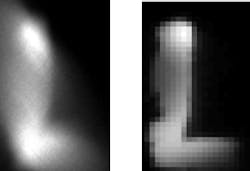CAOS Smart Camera captures bright targets in CDMA-mode
Nabeel Riza, chair professor of Electrical Engineering, University College Cork (Cork, Ireland), and his team have demonstrated enhanced imaging capabilities with their CAOS smart camera. Earlier in 2016, the new multi-spectrum camera technology called CAOS or Coded Access Optical Sensor working in unison with today’s CCD/CMOS/FPA sensors was able to pull out image features reaching a record 136 dB linear dynamic range reported in the online open access International Optical Society (OSA) high impact journal Optics Express of 12 December 2016.
RELATED ARTICLE: CAOS-CMOS camera has 1000X better dynamic range
In the recent work reported in the Optics Express 11 December 2017 issue, the team demonstrates robust and higher-speed simultaneous pixels imaging of bright targets in the visible band without engaging any optical attenuation that can otherwise eliminate faint targets within an extreme dynamic range scene plus reduce image quality of the bright targets.
The team shows that the CMOS-mode of the CAOS smart camera is first engaged with optimized optical attenuation and CMOS sensor integration time control to provide an initial contour guiding best acquirable map of the target space. As is visually seen, this image map of an irregular shaped target sign "L" is lacking in pixel irradiance data robustness (image on left) due to inherent limitations in commercial multi-pixel CMOS sensors.
By engaging the new fast image capture CDMA-mode of the CAOS camera, a high pixel irradiance robustness image map is successfully captured (right image) without the use of any optical attenuation subjected to the incident scene light. These new demonstrated capabilities of the multi-spectrum CAOS smart camera can create impact in various scenarios with bright targets within extreme dynamic range scenes such as in automotive vision, laser metrology, biomedical imaging, defense, and industrial machine vision.
SOURCE: University College Cork; https://www.ucc.ie/en/soe/
About the Author

Gail Overton
Senior Editor (2004-2020)
Gail has more than 30 years of engineering, marketing, product management, and editorial experience in the photonics and optical communications industry. Before joining the staff at Laser Focus World in 2004, she held many product management and product marketing roles in the fiber-optics industry, most notably at Hughes (El Segundo, CA), GTE Labs (Waltham, MA), Corning (Corning, NY), Photon Kinetics (Beaverton, OR), and Newport Corporation (Irvine, CA). During her marketing career, Gail published articles in WDM Solutions and Sensors magazine and traveled internationally to conduct product and sales training. Gail received her BS degree in physics, with an emphasis in optics, from San Diego State University in San Diego, CA in May 1986.
